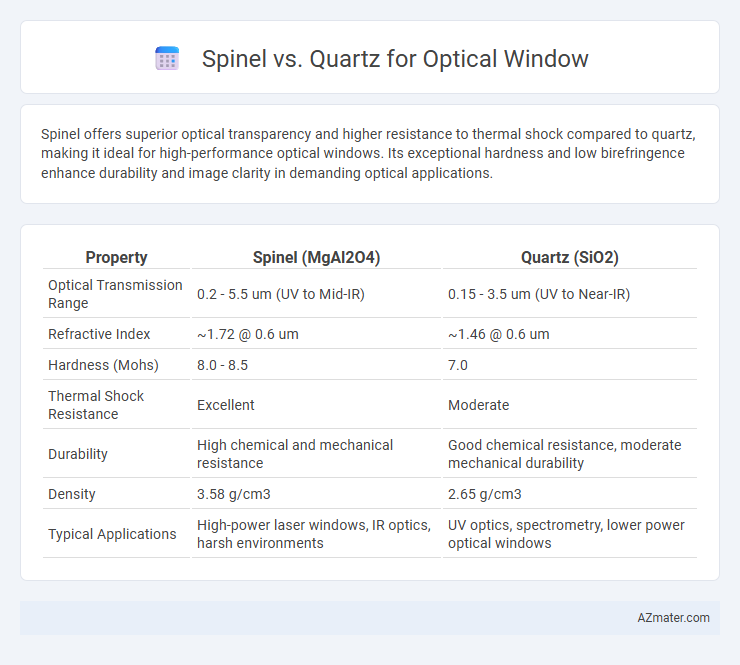Spinel offers superior optical transparency and higher resistance to thermal shock compared to quartz, making it ideal for high-performance optical windows. Its exceptional hardness and low birefringence enhance durability and image clarity in demanding optical applications.
Table of Comparison
| Property | Spinel (MgAl2O4) | Quartz (SiO2) |
|---|---|---|
| Optical Transmission Range | 0.2 - 5.5 um (UV to Mid-IR) | 0.15 - 3.5 um (UV to Near-IR) |
| Refractive Index | ~1.72 @ 0.6 um | ~1.46 @ 0.6 um |
| Hardness (Mohs) | 8.0 - 8.5 | 7.0 |
| Thermal Shock Resistance | Excellent | Moderate |
| Durability | High chemical and mechanical resistance | Good chemical resistance, moderate mechanical durability |
| Density | 3.58 g/cm3 | 2.65 g/cm3 |
| Typical Applications | High-power laser windows, IR optics, harsh environments | UV optics, spectrometry, lower power optical windows |
Introduction to Optical Window Materials
Spinel and quartz are prominent materials used for optical windows due to their excellent transparency and durability across various wavelengths. Spinel offers superior abrasion resistance and thermal stability compared to quartz, making it ideal for harsh environments. Quartz provides exceptional UV transmission and chemical inertness, which is critical for high-precision optical applications.
Overview of Spinel and Quartz
Spinel is a transparent polycrystalline ceramic known for exceptional hardness, high thermal conductivity, and excellent optical transmission from UV to mid-infrared wavelengths, making it ideal for durable optical windows in harsh environments. Quartz, a crystalline form of silicon dioxide, offers high transparency in the UV to near-infrared spectrum, outstanding chemical stability, and low thermal expansion, which ensures optical clarity and structural integrity under varying temperatures. Both materials serve critical roles in optical windows where their differing spectral ranges and mechanical properties influence application-specific performance.
Physical and Chemical Properties Comparison
Spinel offers superior hardness of 8 on the Mohs scale compared to quartz's 7, enhancing scratch resistance and durability in demanding optical environments. Chemically, spinel is a magnesium aluminate (MgAl2O4) with outstanding thermal stability up to 2100degC, whereas quartz (SiO2) exhibits lower thermal resistance around 573degC due to its phase transition. Optical windows made from spinel provide higher fracture toughness and greater resistance to chemical corrosion, making it ideal for harsh industrial and military applications where both mechanical strength and chemical inertia are critical.
Optical Transmission Range
Spinel offers a broad optical transmission range spanning from 0.25 to 5.5 microns, outperforming quartz, which typically transmits from 0.17 to 2.5 microns. This extended range allows spinel to be more effective for infrared applications, especially in the mid-wave and long-wave infrared spectrum. Quartz remains preferred for UV to visible light due to its exceptional clarity and lower cost, but spinel's durability and transmission make it superior for demanding optical windows requiring wider spectral coverage.
Mechanical Strength and Durability
Spinel exhibits superior mechanical strength compared to quartz, with a higher hardness rating of 8 on the Mohs scale versus quartz's 7, making it more resistant to scratches and impact. Spinel's exceptional toughness and resistance to thermal shock enhance its durability in demanding optical window applications, outperforming quartz under harsh environmental conditions. Quartz, while offering excellent optical clarity and chemical stability, falls short in mechanical robustness when durability is critical.
Resistance to Environmental Factors
Spinel offers superior resistance to harsh environmental factors such as moisture, chemicals, and high temperatures compared to quartz, making it ideal for optical windows in extreme conditions. Its exceptional hardness and chemical inertness ensure minimal degradation or discoloration over time, maintaining optical clarity in corrosive or abrasive environments. Quartz, while durable, is more susceptible to thermal shock and chemical attack, limiting its effectiveness in environments with rapid temperature fluctuations or acidic exposure.
Thermal Stability and Performance
Spinel exhibits superior thermal stability compared to quartz, maintaining structural integrity at temperatures exceeding 2000degC, making it ideal for high-temperature optical window applications. Quartz, while more cost-effective, has a lower thermal tolerance around 573degC, leading to potential deformation or loss of optical clarity under intense heat. Spinel's robust performance under thermal stress ensures minimal signal distortion and enhanced durability in harsh environments, outperforming quartz in high-performance optical systems.
Cost and Availability
Spinel offers superior optical clarity and higher durability compared to Quartz but comes with a significantly higher cost, often making it less accessible for budget-sensitive projects. Quartz, widely available and cost-effective, remains the preferred choice for many optical window applications where price and easy procurement are critical factors. The difference in raw material costs and manufacturing complexity drives the price gap, positioning Spinel for specialized uses requiring greater performance despite limited availability.
Common Applications in Industry
Spinel offers superior optical clarity, high hardness, and excellent thermal resistance, making it ideal for defense and aerospace applications such as infrared windows, sensor covers, and missile domes. Quartz is widely used in telecommunications, precision optics, and ultraviolet lithography due to its high UV transparency and stable thermal expansion properties. Both materials serve critical roles in industries requiring durable, transparent windows with distinct optical and environmental performance benefits.
Key Considerations for Material Selection
Spinel offers superior hardness (8.0 Mohs) and excellent broadband transmission from UV to mid-IR (0.2 to 5.5 microns), making it ideal for high-durability optical windows in harsh environments. Quartz exhibits high optical clarity, low thermal expansion, and UV transparency (0.18 to 3.5 microns), preferred for precision instruments requiring dimensional stability. Key considerations include spectral range, mechanical strength, thermal properties, and environmental resistance to optimize performance and lifespan in specific optical applications.

Infographic: Spinel vs Quartz for Optical window
 azmater.com
azmater.com